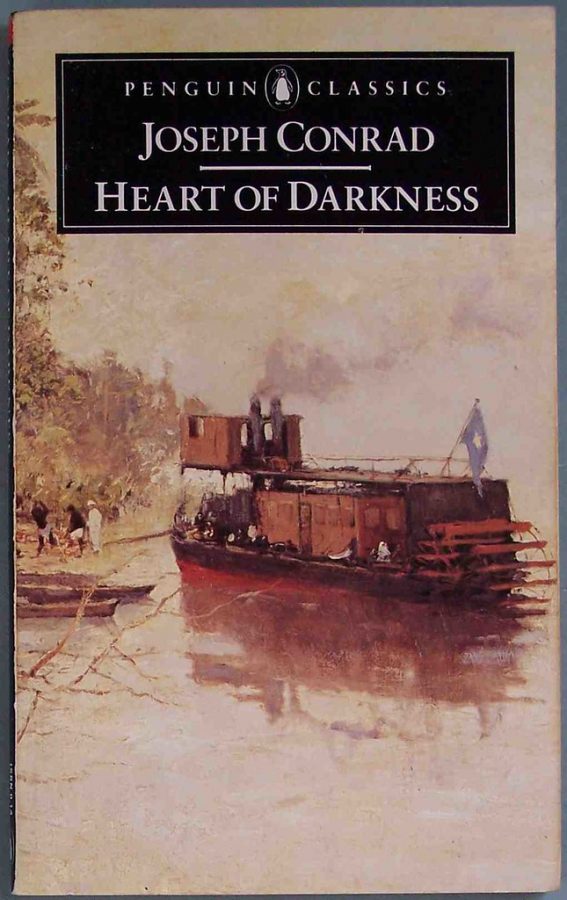In Defense of Controversial Literature
Nigerian novelist Chinua Achebe advocates for the omission of Joseph Conrad’s imperialist tale Heart of Darkness from the typical selection of classic literature, writing in An Image of Africa, “The question is whether a novel which celebrates…dehumanization, which depersonalizes a portion of the human race, can be called a great work of art. Our answer is: No, it cannot.” Achebe is wrong.
Achebe objects to Heart of Darkness because it focuses on the effects of the Congolese jungle on its white occupants, thereby marginalizing the African people, trivializing their way of life, and reducing them to mere props in the background. Critics argue that Conrad’s inexcusable bigotry, hypocrisy, and racism has perpetuated European colonialism and superiority. Conrad, through his alter-ego narrator Marlow, criticizes the Belgian company’s colonial practices but promotes the more “up-to-date” British way of expanding an empire. Though he disapproves of the hypocritical colonists who use religion as an excuse for their greed and violence, Conrad associates darkness, silence, and madness with the “ugly” and “savage” Africa. Under Conrad’s pen, the African natives speak nothing but “violent babble” and “grunting sounds.” He only lends the Congolese a voice twice in a novel which spans months in the Congo, which speaks volumes of his attitude towards them. Conrad overgeneralizes and dismisses Africa for its thick jungles and “incomprehensible and inexpressible” inhabitants; thus, Achebe is right that depicts Africa only as a foil for European civilization.
But Heart of Darkness is brilliant; even Achebe acknowledges its artistic merit. Through Marlow’s unique styles of observation and storytelling, Conrad gives us the first modernist novel, which inspired a generation of writers to experiment with temporality and symbolism to understand the human mind. Marlow’s narrative alternates between the past and the present, overfilled with pieces of memory and Marlow’s own philosophy. Conrad abandons the cut-and-dry definitions attached to symbols of his realist predecessors; instead, he allows readers themselves to ascribe meaning to his imagery. This ambiguity enriches Heart of Darkness. What do light and dark represent in the story? Does Marlow’s quest for enlightenment go too far? Should the jungle of the Congo be penetrated by the white man? Is Kurtz a genius or a madman? What does “The horror, the horror!” mean? Who is the good guy? Conrad radically departs from realist character arcs to explore the human condition, thus opening the door to a new literary movement which dissects characters’ psyches and gives readers freedom and space to form their own judgements and interpretations.
Today, we can understand Conrad’s predicament. To develop a setting for this deep dive into the sea of human conscience, he needed realistic and familiar parameters within the terra incognita of the Congo. If he were to give the natives a voice, how would they speak? Conrad understood little about Congolese languages, traditions, or cultures; neither did his predominantly white audience in Europe and America. It is as easy for the contemporary audience to deplore Heart of Darkness for its appropriation and hypocrisy as it was for 20th century Europeans to praise it solely by its language and structure. However, we are equipped with a greater perspective on in racial justice and imperial history which Conrad lacked, meaning we can and should read Conrad as an exemplar of form and style as well as of appropriation and racism. We can claim a relatively objective view on Conrad’s society and context thanks to greater awareness of racial, colonial, and slavery-related issues. It is imperative that we continue to embrace Heart of Darkness for both its ugliness and beauty.
We can extend Achebe’s argument to social identities beyond race –– religion, for example. The message is the same: our understanding of humanity should enable us to both criticize and to appreciate literary works without blind acceptance of their messages.

Let’s examine an equally controversial work authored by someone at the pinnacle of English literature. William Shakespeare’s The Merchant of Venice has become the cynosure of artistic censorship in light of historical and recent events of anti-Semitism in the United States. Its alternative title, “The Jew of Venice,” summarizes the central conflict – the “righteous“ Christians versus the “villainous” Jew. Throughout the play, Shylock, the titular merchant, suffers from discimination and alienation and, ultimately, is denied his chance to avenge himself. Lancelot the clown resolves to run away from his Jewish master whom he calls “the very devil incarnation” (II.ii.25); Shylock’s daughter Jessica plans to convert to Christianity and elope with her lover Lorenzo. Shylock recalls his own mistreatment by Antonio, his Christian colleague and competitor:
He hath disgraced me, and hindered me half a million; laughed at my losses, mocked at my gains, scorned my nation, thwarted my bargains, cooled my friends, heated my enemies, and what’s his reason? – I am a Jew.
(Merchant of Venice, III.i.51-54)
While we would find no difficulty in denouncing these actions, many of Shakespeare’s audience members would have rooted for these attacks against the Jewish antagonist. Shakespeare’s England shunned all Jewishness: rhetorics of nationalism and Protestant exceptionalism dominated Elizabethan streets; any person of Jewish descent or faith would have faced discrimination; even the word “Jew” became part of the common profanity, associated with traits such as “greedy,” “untrustworthy,” and “cheap.” The Merchant of Venice contains outrageously anti-Semitic content, and Shakespeare deliberately made this choice to match the taste and ideology of his audience, which, though diverse in social class, was firmly united against Judaism.
However, even those who are triggered by the plot and language should not dismiss the entire play. The Merchant of Venice does not endorse anti-Semitism; as a matter of fact, the play questions it by exposing the fallacies and hypocrisy within the “heroes.” Antonio, unlike a proper Christian who turns the other cheek, verbally assaults Shylock because he “like[s] not fair terms” (I.iii.192). Portia speaks eloquently about “the quality of mercy” in one moment but seizes all Shylock’s properties in the next (IV.i.190). The Christians – Antonio, Portia, the audience – want the better end of the deal even if it means injustice; they want to hurt those who would not listen to them even if it means breaking their promise. Domination and revenge bring intense physical and emotional satisfaction to all humans, male or female, Christian or Jewish. They are a human response to pain, and Shylock, unlike his Christian peers who hide behind the false “moral superiority” of their religion, is the only one who has the courage to admit it:
If you prick us, do we not bleed? If you tickle us, do we not laugh? If you poison us, do we not die? And if you wrong us, shall we not revenge? If we are like you in the rest, we will resemble you in that. If a Jew wrong a Christian, what is his humility? Revenge. If a Christian wrong a Jew, what should his sufferance be by Christian example? Why, revenge! The villainy you teach me I will execute, and it shall go hard but I will better the instruction.
(III.i.64-72)
Perhaps rather than a celebration of another Christian victory, we should read The Merchant of Venice as a tragedy of Jewish persecution and Shakespeare’s reproof of social and legislative injustice. One could blame Shylock for his own downfall; if only Shylock resisted his desire for revenge (“like a Christian would,” they might add) and settled with Portia and Bassanio, none of this would have happened. Yet, the trick (which Portia used dexterously) is “Christian blood”; had Antonio been of any other faith, he would have died painfully – but justly – under Shylock’s blade. In other words, being a Christian absolves Antonio from all his sins and crimes against Shylock and, in an instant, turns the victim into the aggressor.
Unmistakably, much of Heart of Darkness reads as racist as Merchant of Venice reads anti-Semitic, and we may feel uncomfortable and insecure when reading them. Yet, remember that we, the 21st-century audience, understand more about the nature of the human race than those who came before. Complete elimination of culturally offensive or dangerous texts is cowardly and counterproductive; with deeper understanding of race, religion, and history, we must learn to question not shun, criticize not demonize troublesome works of literature.






